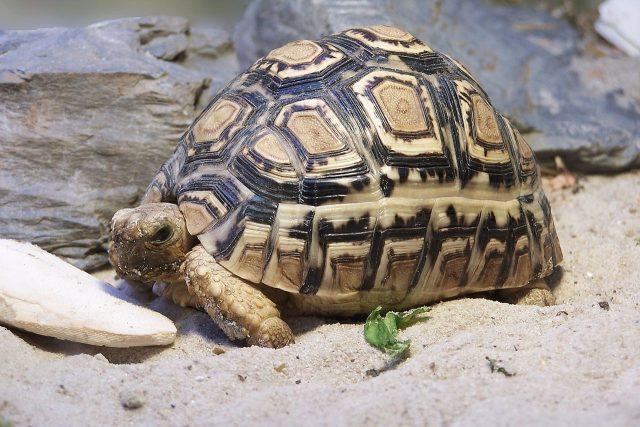Type the name of the breed you're looking for below
[wpdreams_ajaxsearchlite] Don't see the breed your're looking for? Click here and let us know!
Leopard Tortoise
| Place of Origin and Range | The Leopard tortoise is a large and attractively marked tortoise found in the savannah of eastern and southern Africa, from Sudan to the southern Cape. |
| Description | The carapace is high and domed, sometimes with pyramid shaped scales. Juveniles and young adults are attractively marked and the markings on each individual are unique. The skin and background colour are cream to yellow, and the carapace is marked with black blotches, spots or even dashes or stripes. However, in mature adults the markings tend to fade to a slate-y, nondescript brown or grey, commonly tinged with the local dust. |
| Morph Patterns Available | Yes |
| Adult Size | Can grow up to 20in(50cm) |
| Accommodation | Arid Rocky or savannah habitat. To avoid injuries anchor any rocks in the vivarium before you add the substrate. In this case sand. You will want to include a large dish for bathing and soaking in to improve shedding. Always include a day basking spot at 80'F(27'C). Along with multiple hides. Minimum 2 x 8 feet for an adult. |
| Lifespan | Can live 20 - 50 years |
| Feeding / Diet | Not surprisingly, given its propensity for grassland habitats, it grazes extensively upon mixed grasses. |
| Breeding | A very long-lived animal, the leopard tortoise reaches sexual maturity between the ages of 12 and 15 years. Captive leopard tortoises, however, grow faster and may mature as young as 6 years of age. Leopard tortoises "court" by the male ramming the female. When mating, the male makes grunting vocalizations. After mating, the female lays a clutch consisting of 5 to 18 eggs. |
| Other Considerations | Watch for theses health concerns carefully with your tortoise. Vitamin A Deficiency: Vitamin A is an important nutrient for your tortoise’s health. It is found in his diet in the form of leafy green, orange or yellow vegetables, liver, and fish. If your tortoise is not getting enough Vitamin A, he can suffer serious health problems. Always check to make sure that your tortoise does not have swollen eyelids, as this is the main sign of a Vitamin A deficiency. Also, check for weight loss, nasal discharge and infected skin. Any of these symptoms could point to a deficiency. If you think your tortoise may not be getting enough Vitamin A, you should take him to the veterinarian to get a firm diagnosis. Shell Problems: Your tortoise's shell is very important to his overall health. There are many potential problems that could occur, so you should be on the lookout at all times. Respiratory Disease: Respiratory infections have symptoms similar to vitamin A deficiency, including swollen eyelids and runny nose, so you should take your tortoise to the veterinarian to get a proper diagnosis if you suspect either. More serious infections will be characterized by breathing through the mouth, mucus in the mouth, and wheezing. Always make sure your tortoise’s environment has the proper amount of humidity, as this will help prevent respiratory problems. |



